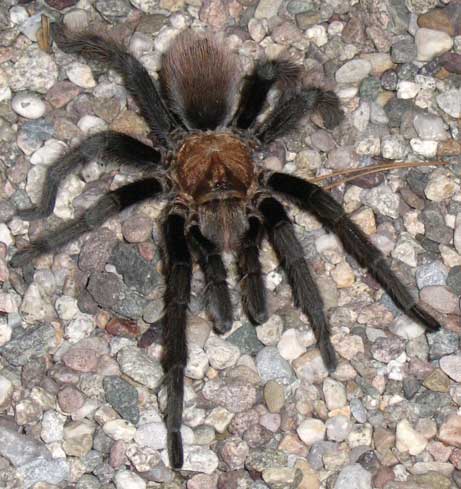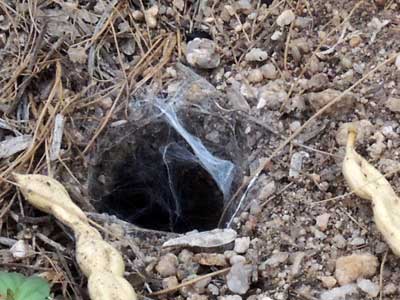Desert Tarantula
Aphonopelma

Image taken in Tucson, Arizona submitted by Bob Kolbert on Aug. 16, 2002.
Therophosidae -- Tarantula Spider Family
This handsome and mostly harmless male tarantula was out searching for a suitable mate when encountered in a driveway in northeast Tucson. Normally this is an end-of-life adventure for a tarantula. Predation by an owl or other predator is a distinct possibility. Otherwise they will burn all their remaining energy searching. Success in finding a female may even end in being the next meal. Normally by October the current year's mature males have all died. Their sperm cells will live on, however, for many years within the female inside a special sac, the spermatheca, fertilizing her eggs as needed. Female spiders rarely leave the safety of their silk-lined burrows.
Males before they reach maturity remain inside their burrows rarely venturing more than a few decimeters from the entrance to capture prey. Females remain in the burrow throughout their life which can span 10 or more years. Sonoran Desert Tarantulas may bite in defense, but their most effective weapon is the abundant, irritating hairs on the abdomen. A skunk or grasshopper mouse seeking to dine on a tarantula must deal with these hairs or else suffer the consequences. In the McDowell Mountains I found dozens of tarantula chelicerae (fangs) in great-horned owl pellets.
More Information:
- Bugguide.net Univ. of Iowa
- Wikipedia
- Google Images
- Google Scholar Literature Search
- Book Reference: Venomous Animals of Arizona by Robert Smith (who was one of my profs at U.A.) available at Abe Books.

Catalina State Park, July 2016.